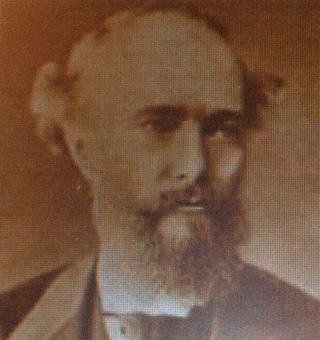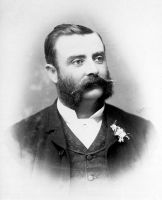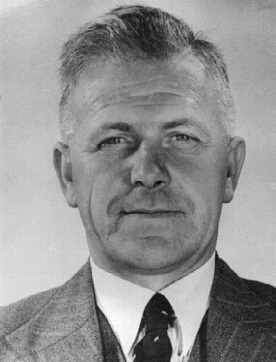
State Library Victoria (SLV) is the state library of Victoria, Australia. Located in Melbourne, it was established in 1854 as the Melbourne Public Library, making it Australia's oldest public library and one of the first free libraries in the world. It is also Australia's busiest public library and, as of 2023, the third busiest library globally.

William Wilkinson Wardell (1823–1899) was a civil engineer and architect, notable not only for his work in Australia, the country to which he emigrated in 1858, but for a successful career as a surveyor and ecclesiastical architect in England and Scotland before his departure.

Joseph Reed was a Cornish-born architect in Melbourne, Australia in the Victorian era. He established his practice in 1853, which through various partnerships and name changes, continues today as Bates Smart, one of the oldest firms continually operating in Australia.

William Pitt was an Australian architect and politician. Pitt is best known as one of the outstanding architects of the "boom" era of the 1880s in Melbourne, designing some of the city's most elaborate High Victorian commercial buildings. He worked in a range of styles including Gothic Revival, Italianate, French Second Empire, and his own inventive eclectic compositions. He had a notable second career after the crash of the 1890s, becoming a specialist in theatres and industrial buildings.

The Great Hall of the University of Sydney, is one of the principal structures of The University of Sydney, New South Wales, Australia, with a public interior used for formal ceremonies, conferences, recitals and dinners. The Hall, located in the Main Quadrangle on the Camperdown campus, is a symbol of the university's stately history and an excellent example of Victorian Academic Gothic revival architecture. Completed in July 1859, the Great Hall soon became a tourist attraction; the writer Anthony Trollope wrote home in 1874 that the Hall was "the finest chamber in the colonies", and that no college of Oxford or Cambridge possessed a hall "of which the proportions are so good".

Architecture of Australia has generally been consistent with architectural trends in the wider Western world, with some special adaptations to compensate for distinctive Australian climatic and cultural factors. Indigenous Australians produced a wide range of structures and places prior to colonisation. Contemporary Indigenous practitioners are active in a broad range of built environment fields. During Australia's early Western history, it was a collection of British colonies in which architectural styles were strongly influenced by British designs. However, the unique climate of Australia necessitated adaptations, and 20th-century trends reflected the increasing influence of American urban designs and a diversification of the cultural tastes and requirements of an increasingly multicultural Australian society.
Bates Smart is an architectural firm with studios in Melbourne and Sydney, Australia. Founded in 1853 by Joseph Reed, it is one of Australia's oldest architectural firms. Over the decades, the firm's practices involving architecture, interior design, urban design, strategy, sustainability and research, have been responsible for some of Australia’s most recognizable buildings.

Dr Norman Kingwell Day is an architect, educator, and writer.
Australian non-residential architectural styles are a set of Australian architectural styles that apply to buildings used for purposes other than residence and have been around only since the first colonial government buildings of early European settlement of Australia in 1788.

Sir Leslie Harold Martin, was an Australian physicist. He was one of the 24 Founding Fellows of the Australian Academy of Science and had a significant influence on the structure of higher education in Australia as chairman of the Australian Universities Commission from 1959 until 1966. He was Professor of Physics at the University of Melbourne from 1945 to 1959, and Dean of the Faculty of Military Studies and Professor of Physics at the University of New South Wales at the Royal Military College, Duntroon, in Canberra from 1967 to 1970. He was the Defence Scientific Adviser and chairman of the Defence Research and Development Policy Committee from 1948 to 1968, and a member of the Australian Atomic Energy Commission from 1958 to 1968. In this role he was an official observer at several British nuclear weapons tests in Australia.

The former Bank of Australasia Headquarters is an historic bank headquarters in Renaissance Revival style located on the corner of Queen Street and Collins Street, the traditional heart of Melbourne's financial precinct, with 19th Century banks on three corners.

The architecture of Melbourne, Victoria, and Australia is characterised by a wide variety of styles. The city is particularly noted for its mix of Victorian architecture and contemporary buildings, with 74 skyscrapers in the city centre, the most of any city in the Southern Hemisphere.

The Chemistry Building is a university teaching facility used by the University's School of Chemistry, located at Masson Road, The University of Melbourne, Parkville Campus, Melbourne, Victoria, Australia. The building was designed by Percy Edgar Everett, who at the time was employed by the Victorian Public Works Department. It was built in 1938 at a time of major expansion at the University through the 1920s and 1930s.

The Old Pathology Building, officially renamed as the Elisabeth Murdoch Building, is an educational building, part of the Parkville campus of the University of Melbourne, in Melbourne, Victoria, Australia. The building is located at 156-292 Grattan Street as building number 134, campus reference number F20. Built in 1885 by architects Reed, Henderson & Smart, the Old Pathology Building is of historical and architectural significance to the State of Victoria, due to its example of early English Gothic architecture and its continued use as a university building for over 100 years. The building was added to the Victorian Heritage Register on 24 June 1992.

The Baldwin Spencer Building, also called Building 113, is a university teaching facility that serves as a student service centre, located at 152-292 Grattan Street, The University of Melbourne, Parkville Campus, Melbourne, Victoria, Australia.

The MacFarland Library at Ormond College, the University of Melbourne, completed in 1965, was Frederick Romberg’s second building for Ormond College. The initial scheme for the building in 1962 was a largely classical building that drew on elements from many of Romberg’s buildings from the previous decade. The subsequent revised scheme better complemented the rest of Reed and Barnes’ Gothic Revival Ormond college. The central plan of the library is a tribute to long tradition of library building including the Melbourne Public Library’s domed reading room, which involved Joseph Reed, Selwyn Bates, Norman Peebles and Charles Smart.

The University of Sydney Quadrangle is a prominent quadrangle formed through the construction of several Sydney sandstone buildings located within The University of Sydney Camperdown Campus, adjacent to Parramatta Road, in Sydney, New South Wales, Australia. The Quadrangle is also called The University of Sydney Main Quadrangle. The Quadrangle and its associated main building and interior was listed on the City of Sydney local government heritage list on 14 December 2012.
Dimity Reed is an architect, urbanist and academic. She has been involved in government advisory roles, as well as writing for both The Sun and The Age newspapers.

Launceston Post Office is a heritage-listed post office at 68-72 Cameron Street, Launceston, Tasmania, Australia. It was designed by William Waters Eldridge, with alterations prior to opening designed by Corrie and North. It opened in 1891, while the clock tower was completed in 1903 and altered in 1910. It was added to the Australian Commonwealth Heritage List on 22 June 2004.























